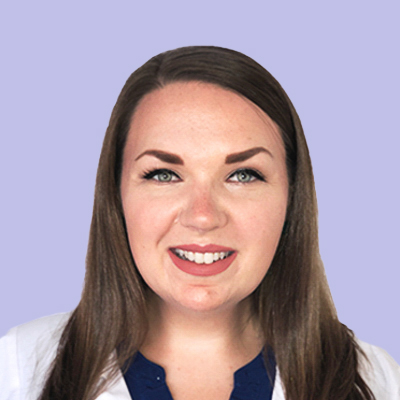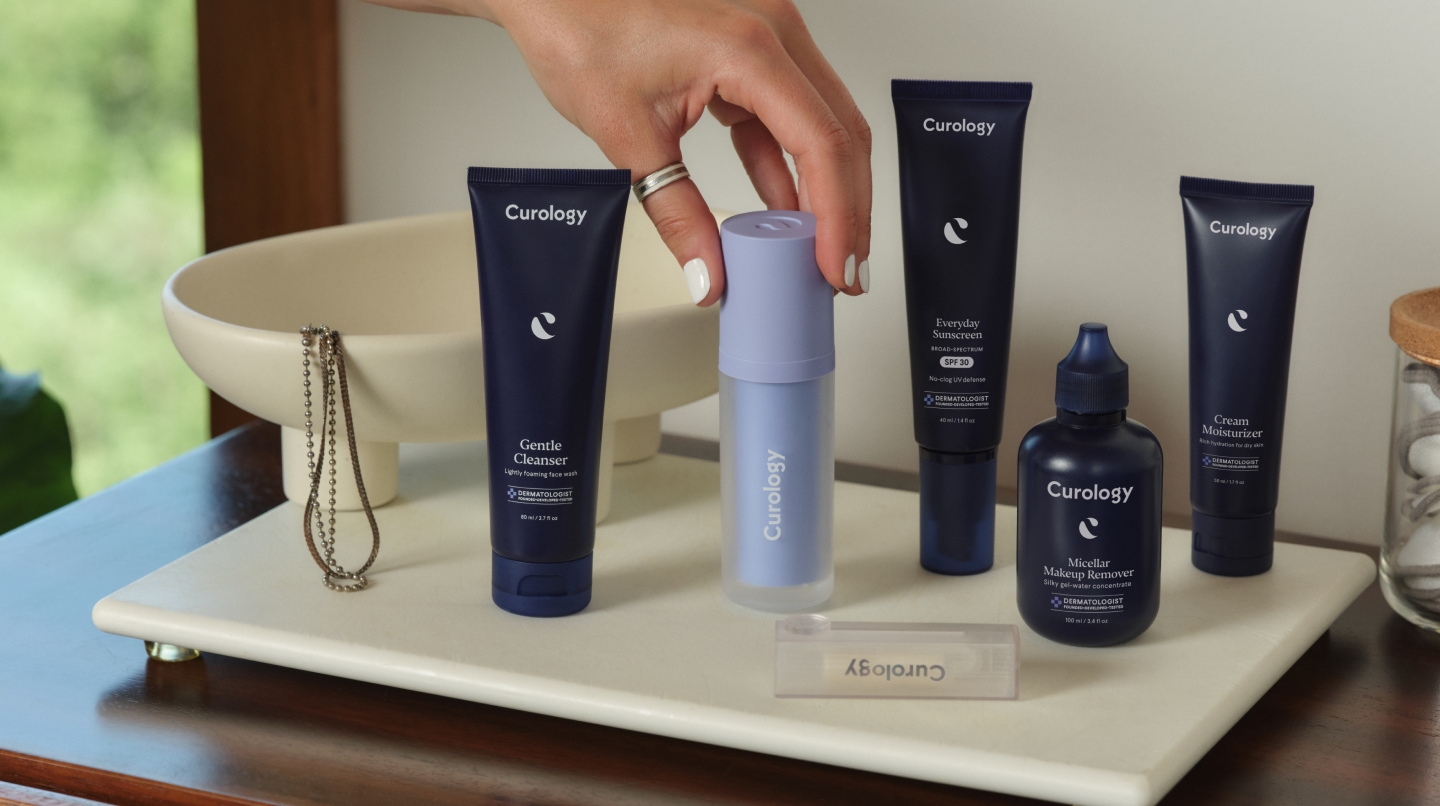How it works:
Share your skin goals and snap selfies
Your dermatology provider prescribes your formula
Apply nightly for happy, healthy skin
How it works:
How it works:
Share your skin goals and snap selfies
Your dermatology provider prescribes your formula
Apply nightly for happy, healthy skin
How it works:
Types of acne: From clogged pores to cysts
Our complete guide to acne vulgaris.



Most of us have experienced acne at some point, but knowing what kind of acne you’re dealing with is essential to finding an effective treatment. For blackheads, following a skincare routine and applying an over-the-counter topical cream will often do the trick. But something like cystic acne, which forms deep inside the pores, may need a prescription from a dermatologist.
This guide explains the different types of acne, its causes, and how acne progresses. We’ll also explain how to treat breakouts and share some ingredients that work for mild, moderate, and severe acne.
Types of acne
Acne vulgaris is a chronic skin condition that begins with clogged pores. It manifests in many ways—everything from non-inflammatory blackheads to inflammatory cysts can fall under the acne umbrella. Acne types include blackheads, whiteheads, papules, pustules, and cysts (or nodules). The differences between the acne types depend on inflammation and whether the blemish is pus-filled, at the skin’s surface, or buried deep in the dermis.
Research shows that some degree of inflammation is involved at every stage of acne vulgaris.¹ But most dermatology providers separate acne into two categories: non-inflammatory and inflammatory. Non-inflammatory acne includes open and closed comedones (blackheads and whiteheads). Inflammatory lesions include what most people think of as pimples (papules and pustules), as well as nodules or cysts that form deep inside clogged pores.
Here are the differences between the various types of acne:
Non-inflammatory acne
Non-inflammatory acne forms open and closed comedones that aren’t red or painful to the touch. There are two types:
Whiteheads: Small clogged pores that look like little white bumps because of trapped oil and dead skin cells. Whiteheads are closed comedones because they’re not open to the skin’s surface. Instead, they form a white, pus-filled head (hence the name!).
Blackheads: Small clogged pores that turn black because the trapped oil and dead skin cells are exposed to the air. Blackheads are called open comedones because they’re exposed to the skin’s surface.
Inflammatory acne
Inflammatory acne manifests as red, painful, inflamed lesions that vary in size. Smaller lesions are called papules and pustules, while larger lesions are cysts or nodules. Here are the differences:
Papules: Tender bumps with redness and swelling caused by inflammation. Papules are usually less than 5 millimeters in size and don’t form a head.
Pustules: “Squeezable” inflamed pimples with a visible central core of pus (that white sludge most people know all too well!). Pustules are usually raised and can be anywhere from 1-5 millimeters in size.
Nodules: Large, firm, reddish lumps that extend deeper than a papule and are often painful. Nodules feel hard and almost knot-like to the touch. They can last for weeks and may require a dermatologist or dermatology provider’s help to treat.
Cysts: These are painful, under-the-skin pimples (sometimes referred to as blind pimples or invisible pimples) that may take a long time to go away. Cysts (aka cystic acne) are inflamed bumps that run deep under the skin’s surface. The difference between cysts and nodules is that cysts generally contain pus.²
“Fungal acne”
Don’t let the name fool you—“fungal acne” isn’t really acne. It’s caused by an overgrowth of Malassezia. It’s an acneiform, more accurately referred to as Malassezia or Pityrosporum folliculitis. It forms clusters of small, uniform pimples that tend to spread across a central area, like the forehead, jaw, chest, or back. “Fungal acne” can be itchy and may form pockets of white or yellow pus.³
Stages of acne
Not every clogged pore or pimple will go through the same stages. That means not everyone with a whitehead or blackhead will experience full-blown pustular acne (thank goodness!). If you treat your skin regularly with the right stuff, like your Curology personalized prescription formula, you can potentially help prevent mild acne such as clogged pores from growing into bigger problems.
Acne severity
Mild acne appears as a few papules, whiteheads, and/or blackheads close to the skin’s surface. It’s mostly non-inflammatory.
Moderate acne appears as more than a few comedones, papules, and/or pustules. It’s generally more likely to be inflammatory.
Severe acne occurs when clogged pores result in a lot of pimples, redness, and inflammation. Large cysts or nodules (greater than 5 millimeters in size) are common.
What causes clogged pores?
Dead skin cells and excess oil (sebum) mix together to clog pores. Normally, dead skin cells slough off on their own, but when there’s too much sebum, build-up can occur that backs up the sloughing process. Acne-causing bacteria, Cutibacterium acnes (formerly known as Propionibacterium acnes) also plays a role along with multiple other complex mechanisms.⁴
It’s a perfect storm of factors that could turn one little pimple into a full-blown breakout—especially if you squeeze, pinch, or pop!
Getting to know pimples
How to treat acne depends on what type of blemish you’re treating. Clogged pores without inflammation can be treated differently from full-blown cystic acne. Here are the basics of pimple management:
Clogged pores without inflammation (blackheads and whiteheads). A proper skincare routine is your first defense against non-inflammatory acne, including a cleanser, treatment cream, and moisturizer. Many over-the-counter treatment options will do the trick. Look for ingredients that exfoliate the skin’s surface and control sebum, like alpha-hydroxy acids (AHAs) and beta-hydroxy acids (BHAs). AHAs and BHAs are available in treatment creams, gels, lotions, and facial cleansers.

Inflamed lesions (papules, pustules, and cysts). When pores become inflamed, prescription acne treatment is generally a better option—not only will you be working under the expert care of a dermatology provider, you’ll be using ingredients proven to fight acne. Prescription-strength clindamycin and tretinoin can treat and help prevent inflamed acne. And remember, the big difference between papules and pustules and cysts or nodules is size and severity. Picking, squeezing, or popping inflamed pimples may make them worse.

Fungal acne. The first step to treating “fungal acne” is to help prevent the environment that makes it thrive. Do your laundry regularly, shower after sweating, and consider adding a skincare product with zinc pyrithione to your routine. Use ingredients with antimicrobial properties that help stop the growth of acne-causing fungus and bacteria.

Pomade acne. Hair care products can also clog pores. Pomade is a waxy or water-based hair styling product that gives hair a shiny appearance. It’s such a common culprit of acne around the hairline that it’s referred to as pomade acne.
You can try an overnight hydrocolloid bandage in a pinch, like Curology’s Emergency Spot Patch. Spot treatments can help calm inflamed acne.
Skincare ingredients to treat acne
Acne-fighting topical ingredients are available OTC or by prescription. Severe acne may require oral prescription acne medication like isotretinoin. Some dermatologists will recommend OTC and prescription combinations, like benzoyl peroxide and clindamycin, which may be used together to help prevent antibiotic resistance. Here are the more common acne-fighting ingredients—both OTC and by prescription:
Benzoyl peroxide is one of the most common OTC ingredients for treating acne. It’s an antibacterial that targets acne-causing bacteria.⁵ Benzoyl peroxide can be found in face washes and cleansers, like the new Curology Acne Cleanser.
Salicylic acid is another popular OTC ingredient. It’s an oil-soluble beta-hydroxy acid that gets deep into the pores to unclog sebum and dead skin cells. It’s generally a good choice for oily skin. Curology uses salicylic acid in its Acne Body Wash to treat breakouts on the back, chest, and shoulders. You can also find salicylic acid in cleansers like Neutrogena Oil-Free Acne Wash, or for a little more muscle, try Paula’s Choice 2% BHA Liquid or Stridex alcohol-free face wipes.
Glycolic acid is an alpha-hydroxy acid available at the drugstore. It’s a chemical exfoliant that can help treat mild to moderate acne.⁶ Glycolic acids are also popular in chemical peels. Glycolic acid can be irritating, so introduce this skincare ingredient slowly—start using it 1-2 times a week and gradually increase as your skin adjusts.
Topical retinoids, like tretinoin, can also be helpful. Tretinoin is available by prescription only and is considered the gold standard for topical acne treatment. It promotes the natural skin cell cycle and boosts collagen production. It can take eight to 12 weeks to notice significant differences, but it’s generally worth the effort. Tretinoin is proven to effectively treat and help prevent acne, especially comedonal acne.⁷ It also may be helpful in treating acne scars over time due to its collagen-stimulating effects. That said, acne scars are typically best addressed by an in-person dermatologist.
Treat Acne with Curology
We’re firm believers that when it comes to clearing up your skin and keeping it healthy and happy, knowledge really is power. Check out our Guides and the Curology blog to learn more need-to-know info that’ll help you along your (sk)individual journey.
We want to be your acne-fighting ally. Sign up for a free trial and get started with your custom acne treatment plan.*
FAQs
Acne starts when the dead skin cells in your pores clog up the works. Normally, these skin cells slough off just fine. But when a pore gets clogged, sebum (the natural oils your body makes to keep your skin moisturized) and dead skin cells build up in there.
Don't! Picking, squeezing, or popping a cystic pimple is the last thing you want to do. You can try an overnight hydrocolloid bandage, like the emergency spot patch by Curology.
Clogged Pores: Ingredients like salicylic acid (a beta hydroxy acid, aka BHA) can be helpful in preventing and treating blocked pores.
Cystic Acne: Picking, squeezing, or popping a cystic pimple is the last thing you want to do with cystic acne!
Fungal Acne: The first step to treating fungal acne is to help prevent the environment that makes it thrive.
P.S. We did the homework so you don’t have to:
Kircik, L.H. Understanding and Addressing the Acne Vulgaris Paradigm Shift. Journal of Drugs in Dermatology. (January 2016).
American Academy of Dermatology. Acne: signs and symptoms. (n.d.).
Rubenstein, R.M. and Malerich, S.A. Malassezia (pityrosporum) folliculitis. Journal of Clinical Dermatology. (March 2014).
Titus, S., Hodge, J. Diagnosis and treatment of acne. Am Fam Physician. (2012 October 15).
Decker, A. and Graber, E.M. Over-the-counter acne treatments. Journal of Clinical and Aesthetic Dermatology. (May 2012).
Babilas, P, et al. Cosmetic and dermatologic use of alpha hydroxy acids. Journal of the German Society of Dermatology. (2012 May 11).
Zaenglein, A., et al. Guidelines of care for the management of acne vulgaris. Journal of the American Academy of Dermatology. (May 2016).
Donna McIntyre is a board-certified nurse practitioner at Curology. She obtained her Master of Science in Nursing at MGH Institute of Health Professions in Boston, MA.
* Subject to consultation. Subscription is required. Results may vary.

Curology Team

Donna McIntyre, NP-BC
Related Articles
How to use acne body wash correctly: Your straightforward guideMen skin care: top concernsHow to get rid of body and back acne?Face sunscreen for sensitive skinWhat is micellar water and how can you use it effectively?Popular Articles
Ask Curology: Is my cold breaking me out?Slugging: The dermatologist-approved skincare hack going viral on TikTokTretinoin vs retinol: What’s the difference?How to create a self-care routine that actually sticksYour 2023 skincare horoscopeTry prescription skincare
Get routine essentials

Good skin days ahead
- Breakouts
- Redness
- Fine lines
- Dark spots
- Hair thinning